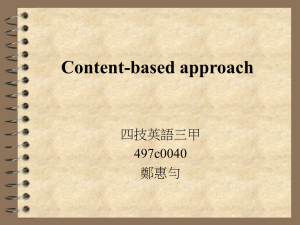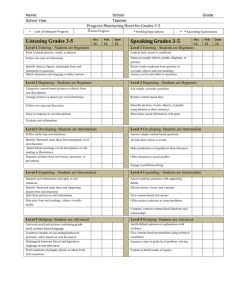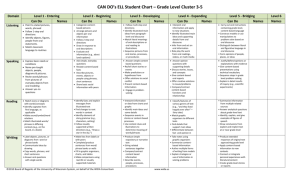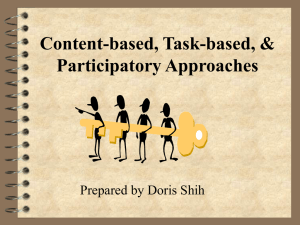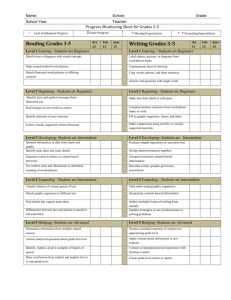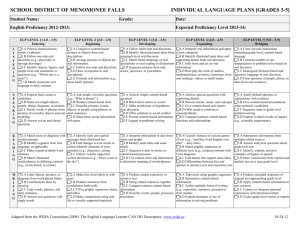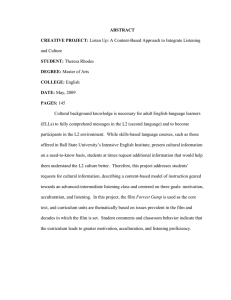Document 15066173
advertisement
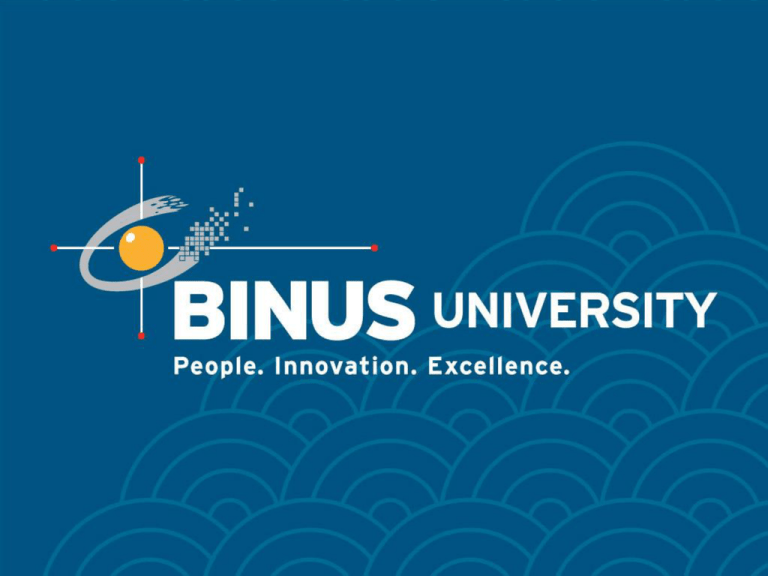
Matakuliah : O0394 – Teknik Reportase dan News Caster Tahun : 2010 The Content Pertemuan 21 - 22 Learning Objectives This section (1) will discuss news from its psychological aspect. The discussion will focus on 2 (two) components: (1) The Content-Based Approaches to News Media, and (2) The Information Processing Approaches to News Reception. The material will discuss how news are put together to set the mind of people. It is actually known that news can be arranged in line with certain situation or even demand. 3 Content-Based Approaches to News Media Which one is the most preferred way of receiving news? It was predicted that the arrival of new media technologies will invariably be accompanied by fears that traditional new sources will become redundant; But newspapers have remained popular perhaps because they perform functions different than those of television and online news; 4 Content-Based Approaches to News Media When first aired, the BBC radio was severely restricted by newspaper owners for fear of losing sales, until the BBC became the state corporation (Scannell & Cardiff, 1991); There are 3 (three) reasons of fearing the lost of sales: First, the more varied program that can be aired in almost as simple and clear way: even the news bulletin can be aired in less than 15 minutes; 5 Content-Based Approaches to News Media Second, another reason is that the new media offered a more varied news subjects from “human interests” to serious crimes; Third, with the improved technology, the new media can now provide news 24 hours a day, with the most well- known Cable News Network (CNN) – a US channel that achieved worldwide fame with its breaking news on Gulf War in early 1990s; 6 Content-Based Approaches to News Media On contrary, the newspapers are also favored for its general interest in political issues and current affairs and being a better predictor than television; It is also stated (Gunter, 1997) that television is less effective in conveying semantic messages than is the newsprint: First, it takes just a slight of time for television to present more than the essential facts while the newspaper may devote several pages for a story/ news; 7 Content-Based Approaches to News Media Second, news programming is chronological and it may cause the loss of attention for a less interest news subject, or it may cause the switch off the television for other activity. With newspaper, we can move to another interesting headline Third, the television does not allow us to refresh our memory on certain interesting subject, while the newsprint allows us to re-read the earlier parts and update our memory. 8 Content-Based Approaches to News Media Then how can the news and the reader be put together? First, the approach that concerns with the content itself; Second, the approach that examines the impact of news on the viewer or the reader. 9 Content-Based Approaches to News Media The approach that concerns with the content itself. What is That? The Content-Based Approach is the way the news is put together by journalists and broadcaster to obtain the expected effects. Meaning, the news is set to form a certain situation. It is the opposite of “magic window” theory that argues that television news is simply a reflection of what’s really happening in the world. 10 Content-Based Approaches to News Media Agenda Setting is the popular content-based approach where it views news as the reflection of the interests in media owners; Agenda Setting is mostly used in purpose by politicians during their elections day - that they cunningly disguise the news or advertisement as their vehicle to win the election; 11 Content-Based Approaches to News Media Other components that use Agenda Setting to set their goals are celebrities, public relations or advertising firms upon the launching of commercial products; The most explicit form of Agenda Setting concerns with the censorship of news where the all sensitive information is hidden on the interest of the news sources. 12 Content-Based Approaches to News Media Another explicit issues of Agenda Setting concerns with large sums of money that is used to secure the “exclusives’ or to compensate for running the scandalous gossip; In politics, there is a term called ‘money politics’ – an amount of fund provided by a certain people or group for the purpose of running their political programs. 13 Information Processing Approaches to News Reception How to measure our ability to interpret or understand news? The knowledge of news reception (how readers and viewers actually understand and interpret news) has two theoretical approaches: the short-term cognitive approach, and the cultivation approach; The short-term cognitive approach is where memory for news material is measured in laboratory-type settings; 14 Information Processing Approaches to News Reception The cultivation approach is where we look at people’s general media use and their understanding of news content; As Gunter (1987) stated that our memory for news is not particularly good due to distracting visual footage that does not always tally perfectly with the verbal material; Means that people may switch their attention from a message because there is a more/ less interesting picture that follows the message. 15 Information Processing Approaches to News Reception With that fact, a news producer would usually delay showing pictures until the details of the story have been read out; Or if the images shown are negative, it will be better if the images are shown upfront because the emotive pictures are considered heighten the viewers’ attention; As Schlesinger (1978) pointed out, news producers organize bulletins in clusters of stories based on thematic similarity (for example: sports, fashion, technology, food, etc). 16 Information Processing Approaches to News Reception The Schelinger’s theory of putting news items in similar theme is very much different with Mundorf and Zillmann (1991) that pointed out the existence of the powerful effect of memorable or spectacular single items that distract viewers or listeners from remembering neighboring items that are rather less spectacular. 17 Closing By learning this material, it is expected that the students can also see news from its other interesting aspect, the psychological aspect. By understanding the other side of news, hopefully the students may be able to view news differently, apart from the meaning of news itself. 18
